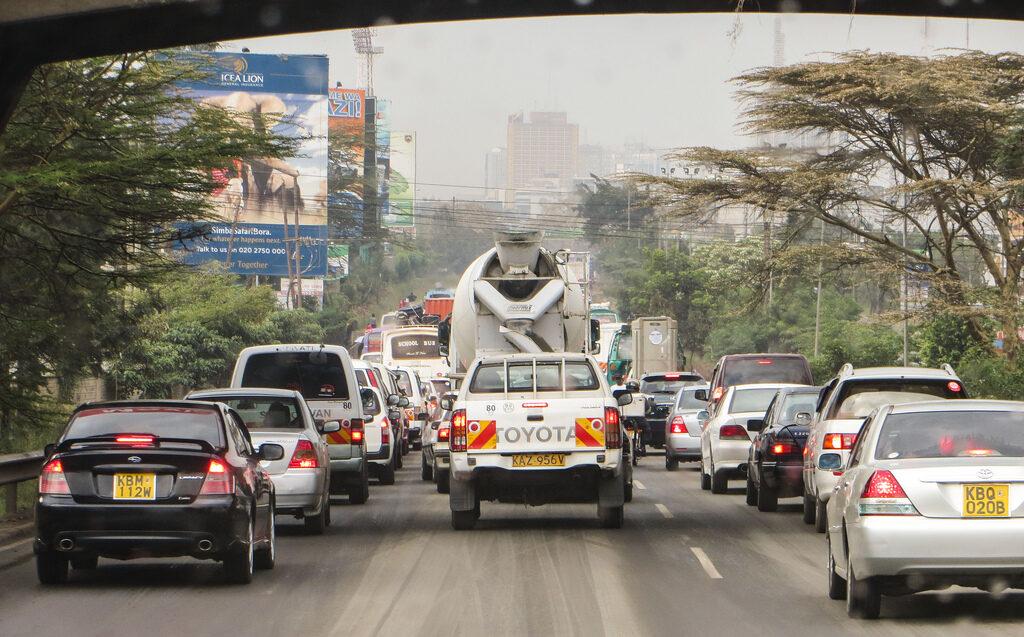30% of trips in Nairobi are made by minibus. Why were they banned?

While other major cities are blocking private cars to encourage the use of buses, Nairobi is moving in the opposite direction.

Nairobi’s congestion problem has many causes but few easy solutions as the matatu ban showed. Credit: chmoss.
Commuting to work in Kenya’s bustling capital Nairobi has never been easy. Beginning as early as 5 am, people begin pouring into the Central Business District (CBD), often spending as much as two hours in the city’s legendarily terrible traffic in the process.
For those that can afford it, a ride in a matatu minibus for 70 Kenyan shillings ($0.70) means avoiding having to walk along busy roads without pavements. This is the second most common form of transport, accounting for 30% of all trips in Nairobi, after walking, which accounts for 40%.
At least for now. At the start of this month, Nairobi County governor Mike Sonko banned the entry of matatus into the city centre. The more than 20,000 minibuses which used to enter each day were forced to stop outside CBD and compete for just 500 parking spots. Passengers were dropped off often several kilometres from their final destinations. From there, they had few options but to walk. Cabs are too expensive for most, while cheaper motorcycle taxis were barred from the centre several months ago.
Understandably, there was a massive public outcry, to the extent that the ban was lifted just two days later. However, it’s still important to ask what informed the short-lived policy. While other major cities like Oslo and Madrid have recently banned private cars downtown in an effort to increase the use of buses and public transport, why is Nairobi driving in the opposite direction?
The problem
By banning matatus, Governor Sonko was trying to tackle a very real problem. Nairobi is hugely congested.
The biggest factor behind this is the built environment itself. The capital is still shaped by segregationist urban planning from the colonial era. Under British rule, authorities encouraged the concentration of businesses downtown and built good connections to the European residence zones to the north and west. These areas are still among the wealthiest in Nairobi. By contrast, few roads were built to the African residence zones to the east and south. Today, these neighborhoods remain poor and poorly connected to the centre, even though more than 60% of the city’s population live there.
This means that huge numbers of Nairobians are forced onto a few main roads to get to work each day. The result: matatu gridlock. The national government has made expanding the road network a top priority, but construction has moved slowly and several projects have been criticised for displacing residents of poor neighbourhoods rather than helping them connect to opportunities downtown.
Another challenge comes from the fact that Nairobi doesn’t have a proper public transit system. Matatus are not government run, but are private vehicles owned by investment groups called savings and credit cooperatives (SACCOs). These groups contract their operations to drivers, who return a fixed amount of their earnings to the SACCO each day and keep the remainder for themselves. With little regulation around timetables or the location of matatu stops, drivers maximise their revenues by congregating in busy areas and driving aggressively between stops to get to the next fare more quickly.
The prospect of introducing fixed routes to manage congestion does not appear likely. Matatus have strongly resisted attempts at even minimal regulation, such as ensuring that they have seatbelts, and their potential to shut down traffic by striking means that the government can’t move against them too strongly.
[Why aren’t we moving? Nairobi’s never-ending traffic nightmare]
The solution
One proposed solution to this state of affairs is the creation of a government-owned bus rapid transit (BRT) system. This would include fixed stops and timetables, dedicated street lanes to avoid congestion, and larger buses to reduce the number of vehicles on the road.
Within East Africa, Rwanda’s capital Kigali has led the way in transitioning from matatus to BRT. Nairobi has actually had its own similar plans for years, but they have yet to be implemented. Challenges have included a lack of funding, opposition from matatu drivers, and some confusing early plans which would have required passengers to board from the center of busy highways rather than at the side of the road. (There was some speculation that the contractor designed the BRT for countries which drive on the right rather than the left, and forgot to flip the plans around for Kenya.)
All of this leaves city officials with few good options for quickly reducing congestion. Expanding the road network or building a desperately-needed light rail system are expensive and long-term solutions. Relocating jobs away from the city centre is infeasible. The transition from loosely-regulated matatus to a BRT system is proceeding slowly.
It is this state of affairs that led the governor to opt for the most superficial symptom of the problem: the large number of buses on the roads. By banning these, Sonko may well have temporarily cleared the CBD. But he did so at the expense of the majority of Nairobians and for the benefit of the just 10% who travel by car, an elite group which is also set to benefit soon from a planned reduction in downtown parking fees.
Like many busy cities worldwide, Nairobi has a serious congestion problem. But forcing poor and middle-income people to walk to work so that the wealthy can drive more easily is not a sustainable solution.





This was a great piece. I was among the affected. Getting back to Embakasi, where I stay, had to walk on that day from the CBD all the way to Nyayo Stadium where I took a matatu.
I think we should stop comparing these countries like Stockholm to Nairobi in the name of people can walk once they are dropped outside the city center. If you have been to Nairobi and saw where the govt is suggesting to make the drop off it’s really to far from where people would have to connect to get to their destination. The distance is really long otherwise I doubt there would have been a great public outcry if it was 1 or 2 km